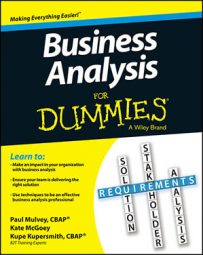Most of the time, you can’t fly all around the world to fabulous international destinations to interview all the stakeholders in your business analysis. So how do you gather information from 4,000 users worldwide? Create a survey (some call it a questionnaire). How do you get them all to respond to the survey? That’s a tougher answer — read on.
Types of surveys for business analysis
Surveys come in two different question type varieties: closed and open-ended. Which type you use depends on the situation:
Closed: Using closed questions is perfect when the responses to a question are known and finite. This type is a Yes/No question, pick a choice from a list, or pick all that apply from a list.
Closed survey question results are easier to analyze than open-ended results because you can add up the like answers and compare and contrast the totals of each response to determine the requirements for your project.
Open-ended: This question type allows for free responses. This type of question is perfect when the responses to the question are not known or the range of responses is large.
The responses are more difficult to analyze, but they give you information from respondents in the respondents’ own words. More information may result from this type of question than from closed questions, which allow only for responses that you include.
Feel free to combine the types of questions in one survey. You don’t have to have a survey of only closed questions and another for open-ended. Regardless of the question type, think through what the goal of asking the question is and determine the best question type to use.
How to maximize the chances of getting a response to your business analysis survey
Be honest: When a website you’re surfing asks you to take a short feedback survey, you usually just close out the window, right? Yet despite the fact that people often ignore survey requests, surveys are a great elicitation technique. Why? Because when done properly, surveys can generate a huge amount of data from a large number of stakeholders.
Here are some pointers to help you create a survey that results in a high participation rate:
Make the respondents want to participate. Money works, but you don’t always have the luxury to offer cash to pay people to complete your survey. If you can’t offer cash (and who can inside a company?), see whether you can offer the project team that gets the most responses a company-branded shirt, a pizza lunch, or whatever other tangible reward works in the organization’s culture.
The point is to figure out what motivator you can offer as the proverbial carrot. If all else fails, you just have to pull the “You have to fill it out because it’s part of the job.” card.
Be honest about survey length. Don’t say it’s a 30-second survey if you know it’ll take at least 8 to 10 minutes. Also, don’t say it has 5 questions when each question has so many subquestions that it’s more like a 60-question survey.
Use closed-ended questions. Rather than ask for long responses, give yes/no options or a rating scale. This setup is easy for both you and the participant. Surveys yield a lot of data, and you don’t necessarily have time to read all open-ended responses.
Weed out participants that don’t fit your demographic upfront. For instance, if you only want people to respond who have dined in a particular restaurant within the last 30 days, ask that question first and then end the survey for anyone who hasn’t dined in.
How to compile and use the business analysis survey data
After you receive the data, you need to pull it all together. Look for trends in the data and for places where you can exploit opportunities. Examine the data to see what calls out to you as the business analyst.

